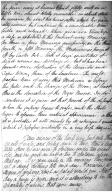[ The Angelyne Tree ] Dr. William James Almon
Date: Late 18th century; exact date unknown.
Source:
Manuscript Notebook of Dr. William James Almon
Institution: Nova Scotia Archives
| Source Origin: Almon Family Fonds
| Reference: MG 1 / Microfilm Reel 10,045
A description of the angelyne tree used as medicine followed by a recipe for decoting its bark as a remedy to expel worms, pp. 225-26. The instructions specify the successful use of the remedies by "Hospital" and "Negro" nurses. Original source unknown.
The Angelyne tree grows to a very considerable
height and is often found in the pastures of the
lower Estates, but much more frequently in the
mountainous tracts, the soil of which, a red clay,
seems to be its nature one-- It is deciduous, but as
the old leaves are succeeded by new ones almost
immediately after they fall, it appears always green.
The leaves grow alternate, and are of an oval
shape, gently serrated, and of a bright green
colour. I have not been able to procure the
Flower, but the Angelyne I am informed bears a
berry of a purple colour when ripe. The Wood
of the Tree is reckoned one of the best species of
hard wood, and boards and planks of it are
preferred in buildings that are much exposed to
the weather -- The Bark of the Angelyne is the
only part of the tree used as a Medicine. Few here
but the Hospital Nurses on Estates make use of it.
It is found by them extremely useful in Dysenteries,
especially when the griping begins to abate, but it is
more generally used as a Vermifuge -- The taste of
the Bark is bitter, but by no means disagreeably
so. As a Medicine it is used in decoction, a hand-ful
of the Bark reduced into a coarse powder is boiled
in two quarts or three pints of Water into a
quart or a pint and an half--of this the Negro
Nurses generally give a small dose at first--and
increase it gradually as they find the patient
able to bear its operation or the disease obstinate.
The effect this Decoction if the quantity exhibited
is more than proportioned to the age and strength
of the patient, is an almost immediate intoxication
The person using it becomes blind, giddy, and in a
little time almost totally insensible, in which state
he remains for about two hours, after which he gradu-
-ually recovers, but continues for a considerable time
feeble and relaxed -- When given as a Vermifuge
a dose is exhibited to the patient every Morning
for three or four Mornings successively; on the third,
fourth, or fifth Morning the Medicine is purged
off by Castor Oil. With it large quantities of
dead worms are discharged but it has been
found more destructive of the Ascarides and
Tape Worm, than of the Lumbrice. The most
proper time of using this Medicine is before
the full and the change of the Moon, at least
this is the observation of the Negro Nurses -- In dy-
-senteries it is given at that period of the disease
when the griping begins to cease, and the stools
begin to assume their natural appearance -- so that
it is probable it acts merely by its astringent quality,
which it possesses evidently in a very high degree.
Four ounces of the bark were put into three
quarts of water, and boiled down to two, then a large
table spoonful was given to children under two years
old, and one and an half or two to children above
that age. It is given early in the morning. They must
eat or drink nothing till mid-day. It occasions a
degree of griping, such as jalap would give. Next
day a purge is given, and it is astonishing to see the
quantity of worms, that come away.
Download: Transcription | Images

